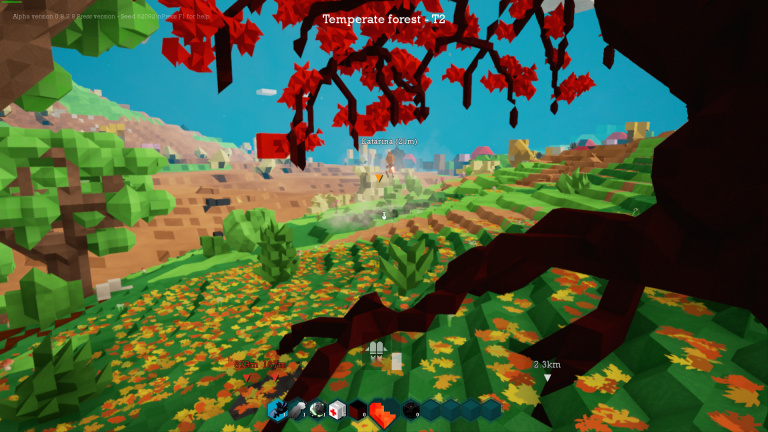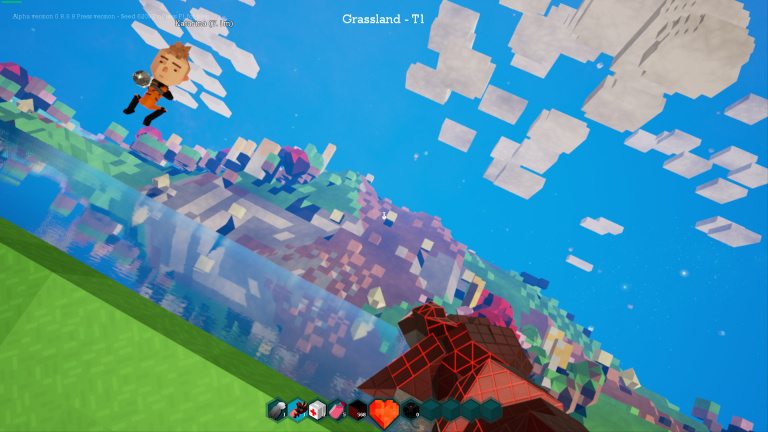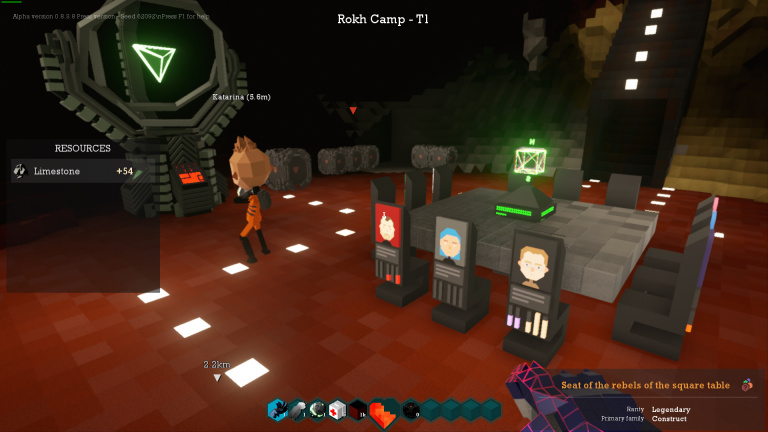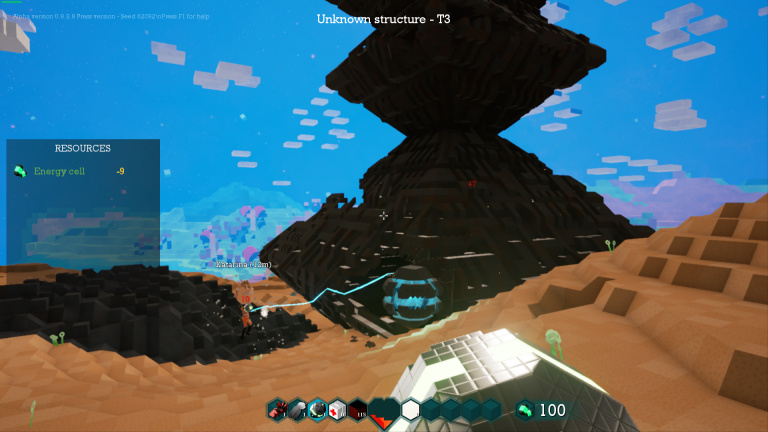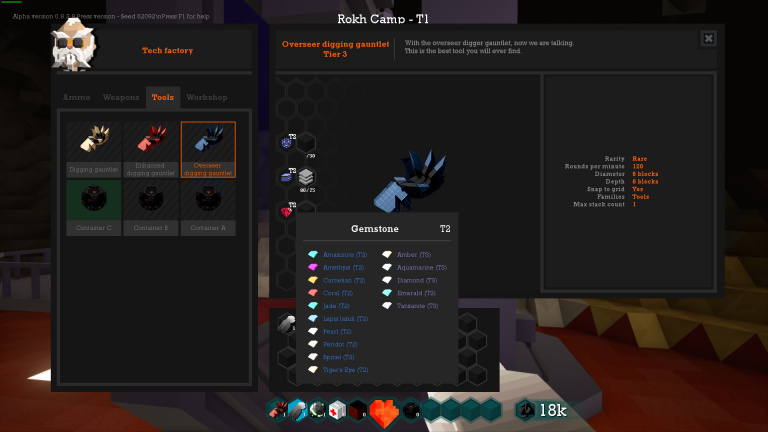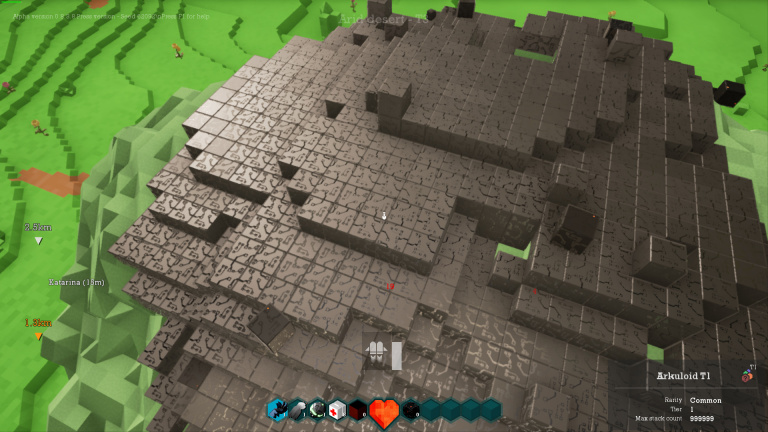Stellar Overload Alpha Impressions

Stellar Overload—formerly known as Planets³—is an upcoming, voxel sandbox game from Cubical Drift. Currently in Alpha, it was originally funded via Kickstarter on April 5, 2014 to the tune of $310,708. The game boasted a unique, intricate plot, RPG elements, a multiplayer focus, and cube-shaped planets as its defining features. Given how many games have been released with similar formulas since Minecraft debuted, however, it would take something quite unique in order to leave a lasting impression. I had a chance to take a look at an Alpha build of the game this week and see whether the game does, in fact, provide a unique experience.
Upon first entering the game, the first thing I noticed was just how pretty the world is. Bright, saturated colors are everywhere on the surface. The use of triangular shapes in addition to simple cubes allowed for much more complex designs. The game renders detail based on a distance set in your options. At the lowest level of detail out in the distance, it looks a bit like someone painted in the background in Hexels. At the best level of detail nearer to you, it almost looks like a complex painting made from simple shapes. The game was far more aesthetically pleasing than I expected it to be and it made the world quite wondrous.
Roaming this world is the oddest assortment of creatures I’ve seen in some time. You will encounter glowing caterpillars, squirrels, fennec foxes, hedgehogs, and peacocks, among others. None of them quite fit together—and one has to wonder why there is such an abundance of peacocks—but it is a marginally more interesting assortment than more rabbits, chickens, and pigs roaming around. Unfortunately, these creatures don’t seem to be fully implemented just yet. The peacocks will remain unanimated when their tail is spread and not all of the creatures provide drops just yet.
Being set on an alien world there is a lot you don’t know about your surroundings. As such, unknown structures are littered around the world, marked on your HUD when you approach them. Each one has a chest that contains various, random higher-tier items and materials. Considering how much each one gives you, it can at times feel as if there are too many. They are guarded by flying drones that shock you, but these drones are easily dispatched. Currently, the rewards far outweigh the risk.
Stellar Overload provides each player with a jetpack for getting around more easily. Used correctly, you can fly into trees—sometimes even clouds!—with ease. You can also easily kill yourself with fall damage, but I digress. There is even the added detail that using your jetpack too close to the ground will kick up a cloud of dust and smoke that blinds you.
As mentioned earlier, one of the game’s defining features is the cubed shape of each planet. When you reach the edge of a planet, you can stare straight off of it, past all of its mountains, and into space. Jumping or walking off the edge will cause gravity to shift in a disorienting manner and you will end up on the other side of the planet. This process was admittedly rather fun. It’s a something simple, but memorable, nevertheless.
There is a vague story in place—the title screen says that it takes place 200 years before the story of the final game—but it doesn’t seem particularly interesting in any way. In the core game world, the game goes a bit further than simply borrowing from the Matrix, awakening you in a place called The Rokh Camp—the supposed last bastion of free humans. One of these free humans tells you to talk to a woman named Amy, who is supposedly “the One.” Going outside, you can find various scientists and men named “Smith,” dressed in black suits with a white shirt. Talking to scientists will generally afford you various hints. Talking to anyone named Smith, however, will result in one of many lines of dialogue attempting to convince you to “connect.”
Based on the assortment of NPCs I’ve encountered so far, it seems that each and every NPC has a set bit of dialogue they share with you whenever you talk to them and it does not change. To get more dialogue, you will have to find more NPCs. That shouldn’t be much of an issue, though, as they are littered around the world almost haphazardly.
At some point, you will speak with Amy, who will explain that there are robotic creatures called Arkuloids that have blighted the land, literally infecting it and turning it robotic. The Arkuloids have stolen some “Cognitron Secret Plans” that you must recover for them. The story takes about 10 minutes of effort once you’ve equipped yourself with a weapon and leaves you wondering why you bothered in the first place. The ending is rather bad and feels a bit like the team went “okay, what cliches can we throw into this to get a full two pages of text in this prompt?” The final game will have an undoubtedly better story, but this one was meager and disappointing. Other than making me feel as if I wandered around an odd alternate reality version of The Matrix, I don’t feel as if I have any more of a grasp on what the final game’s story will entail, despite this being a prequel. Fortunately, you can keep playing the game as a sandbox after you’ve completed the single-mission “story” and continue to enjoy the world without it.
The core of your experience will revolve around marginally the same gameplay mechanics that other games like it have presented in the past. You will be collecting various materials through means such as mining and turning them into items that can help you improve your arsenal and advance your encampment. Unlike most games that revolve around crafting, you do not have a basic crafting menu. You must use a machine in order to refine materials or create items from them. The Kickstarter mentions a deep system of subparts, but that isn’t in-game yet.
The manner in which you actually collect materials is a bit different. All collection is instantaneous. There are various tiers of gauntlet you can use to collect materials. If you have an empty slot or a block selected, you can remove a single Tier 1 block by right clicking. The basic gauntlet collects Tier 1 materials in 8-block cubes. Each higher tier gauntlet will collect higher tier materials in exponentially larger amounts at one time. From what I was able to find in the game’s key lack of instructions, there is no way to change the collection size, meaning that you don’t have nuanced control over collection of materials over Tier 1. Furthermore, materials like water behave oddly. Each space of water is an individual block and you literally mine the water out of the body of water it is a part of, never to be replaced.
At present, there may be just a few too many different materials that do marginally the same thing. There’s a deep system of refinement but, in many cases, the game doesn’t distinguish between various materials of the same class. A Tier 2 metal that has been refined from ore is the same as any other Tier 2 metal. There are very few cases where you need a specific material and, regardless of which material use, the end result is the same. The most obvious case of there being too many materials occurs when you are digging with the Tier 3 gauntlet. You will often end up with three or four different types of dirt showing up in the prompt that tells you how many of each material you’ve obtained. You can hold an infinite amount of each type of material in the slot that it is occupying, but each variation of the material takes up its own slot. Considering the sheer amount of materials the game has currently, your inventory will soon fill up with a dozen or more materials you will likely never need. I can only see this getting worse as the game nears release and more materials are inevitably added. It’s detailed, and it feels fairly realistic, but it ultimately hurts the experience when inventory management becomes very difficult very quickly.
The collection of recipes can be frustrating. There are currently 76 recipes in-game—according to the counter that comes up every time you collect one. You must collect them by finding copper-colored capsules that spawn randomly as you wander around. Each one contains a random recipe and the game gives no consideration to what recipes you have already unlocked when choosing to give you one. You could very well end up with a recipe you can’t even use. You then must hope that the next few capsules contain the recipe you need in order to create the one you just got. There's a different system of "evolution" outlined for the future, but it's not in the game yet and, as such, progression feels random and unintuitive.
Combat plays out like most shooters. The only hostile creatures currently are the Arkuloids and the flying drones that guard unknown structures. Each one has a simple AI that is set to chase you. For the Arkuloids, the ultimate goal is to jump into you, destroying themselves in the process. The drones, on the other hand, get within range of you and shock you repeatedly. You can dodge the Arkuloids, but you cannot dodge the drones’ shocks. The best course of action when dealing with drones is simply to stay out of range.
There are several weapons currently in-game, but I only used two. There is a block thrower that allows you to throw any blocks you’ve picked up at enemies. Rarer, higher tier blocks will deal more damage. Similarly, higher tier block throwers will deal more damage. The other weapon I used was an energy rifle of some sort. A single shot costs an energy cell, which must either be found or crafted. Charging the weapon will allow you to fire a more powerful shot at the cost of three cells. The energy rifle will dispatch every enemy available currently in one or two charged shots. I had unlocked a sonic rifle that fires gas canisters, as well, but did not attempt to use it.
Stellar Overload has a solid base behind it. Despite its simplistic look, the aesthetics are genuinely memorable. There are a lot of features planned that sound quite cool, such as dungeons, group-oriented AI, and profession masters that sound as if they will work a bit like the core NPCs in Terraria. The problem is that none of that is there yet. Right now, all there is is a barebones system of mining and crafting with a paltry preview of a “story.” It is currently impossible to tell if the final product will be something that sets itself apart. The Kickstarter outlines a game that sounds like it will provide much-needed evolution for the genre, but that game isn’t here yet and may not be for some time.
